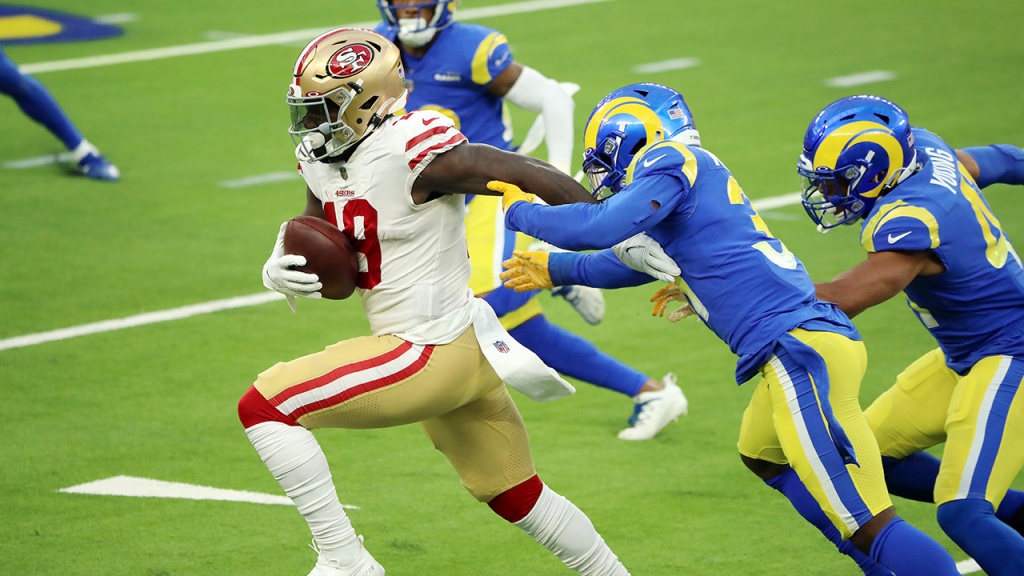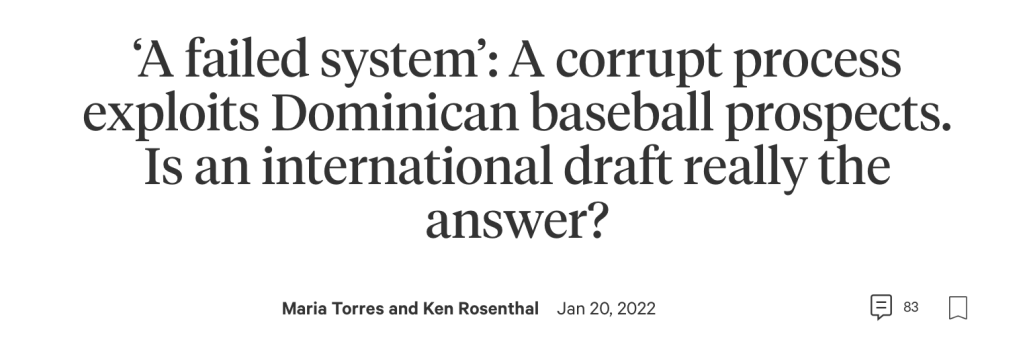
Curt Schilling’s Lopsided Trades
Curt Schilling is a crappy person, but he was a great pitcher and should be in the Hall of Fame. Ok?
Anyways, this is an interesting article, using Schilling having not been elected to the Baseball Hall of Fame this week as jumping off point to discuss an interesting topic: Schilling was traded three times before he was 25, which is very unusual for a player who ends up being as good as Schilling is. In fact, Schilling was the best such player of all-time.
But where this article gets interesting is it dives into each of those three trades: who Schilling was traded with and for, and why the people who made the decision to trade him did so – what they were thinking, using quotes from today and at the time. I particularly liked this passage, with the Astros GM who traded Schilling kicking himself, thirty years later:
Wood authored some of the sport’s most celebrated and ill-advised decisions: He made out like a bandit in the Davis and Andersen deals, but he also traded Schilling for a future reliever/bat thief who never pitched for the Astros, and he failed to draft Derek Jeter with the ’92 no. 1 pick (another byproduct of the team’s premature all-in approach). “I’m also the genius that traded Kenny Lofton,” Wood says, referring to the December ’91 exchange in which he traded Lofton (who was blocked by Finley) to Cleveland for Ed Taubensee to fill a vacancy at catcher created by Craig Biggio’s switch to second base.
“Sometimes there are moves that it takes a lot of years to forget,” Wood says. Thirty-plus years may not be enough. Whenever Wood hears Schilling’s name now, he confesses, “In the back of my mind, I’m saying to myself, ‘Self, you idiot. That’s one guy you should have held on to. Maybe you would have lasted in Houston for five more years than you did.’” Had the mid-’90s Astros had Schilling and Lofton, Wood jokes, “they might have actually beaten the Braves once in a while.”
It’s an interesting look into what goes on in a trade and how a guy like Schilling got moved around so much. As Lindbergh sums up: “Coaching shortcomings, overrated rosters, overvaluing of veterans, underappreciation of prospects, ownership pressure, bad batted-ball luck, and unfortunate timing: All of the above contributed to a late-blooming ace’s itinerant origins.”
Fun article! -TOB
Source: “The Uniquely Confounding Career of Curt Schilling,” Ben Lindbergh, The Ringer (01/26/2022)
PAL: Fantastic angle – traded three times that early only to become an all-timer. First off, I had no idea he was on a team before the Phillies, much less three. Also, it’s crazy how long it took him to actually post a bonkers season:
Schilling was the winningest pitcher on the Phillies’ staff in ’92—which he acknowledged would have seemed laughable before the season—but the path to his peak wasn’t direct. Schilling lost focus for part of ’93, underwent elbow surgery in ’94, and tore his labrum in ’95. It wasn’t until 1997 that he had his first fully healthy, huge year, which his pitching coach that season, Galen Cisco, attributes to his use of video to study hitters, his willingness to pitch inside, and his consistency in spotting unhittable heaters down and away.
Good find, TOB!
The Bosa Mob Connection
Here’s a pretty nutso story: there’s a real NFL bloodline that stems from a Chicago mob boss.
The Niner’s Nick Bosa, his brother and Charger Joey, and some wide receiver on the Bills are all great grandkids of Tony Accardo. Accardo was believed to be Al Capone’s chauffeur, bodyguard, and “potentially more.” When Capone went to Alcatraz and other top dogs fell Chicago, Accardo became the top guy. This was someone you would not want to cross.
Per Katie Dowd:
Most people were wise enough not to cross him. In 1978, while Accardo was lounging in his Palm Springs vacation home, burglars broke into his Chicago mansion. In the following days, at least seven individuals connected to the robbery were found with their throats slit. “One was castrated and disemboweled, his face removed with a blow torch, a punishment imposed, presumably, because he was Italian and should have known better,” the Chicago Tribune wrote.
Perhaps more insane: the number of people in this family that have played professional football:
While his cohorts died violent deaths, Accardo slipped quietly into retirement. It was during this time that his family’s NFL empire began. His daughter Marie married Palmer Pyle, a guard who was selected in the first round of the 1960 AFL draft by the Houston Oilers. Although the marriage didn’t last, the NFL bloodline did. Marie and Palmer’s son, Eric Kumerow (he took the last name of his mother’s second husband), became a Dolphins linebacker…
Kumerow’s sister, Cheryl, married Dolphins defensive end John Bosa, and together they had Nick and Joey, now both in the NFL. In addition, Kumerow’s son Jake plays wide receiver for the Buffalo Bills. Although none in the current generation knew Accardo personally, his legacy still looms large over the family.
As if we needed more reason not to mess with a Bosa. – PAL
Source: “49ers star Nick Bosa is the great-grandson of one of history’s most feared mobsters,” Katie Dowd, SF Gate (01/26/22)
It’s Hard to Beat a Team Three Times in One Season. Or is it?
The 49ers, somehow, are in the NFC Championship game, traveling to L.A. to play the Rams (who they have beaten six straight times. Within those six straight, of course, the Niners beat the Rams twice this season, including a do-or-die game in Week 18 in L.A.

All week, just like we hear every time divisional opponents meet in the playoffs and one team swept the season series, I keep reading and hearing that it’s very difficult to beat a team three times in one season. This has been accepted as gospel as long as I’ve been watching the NFL. But…is it true? I decided to Google that question and found this article which answers the question rather emphatically.
Since the 1970 NFL Merger, there have been 21 instances where a team swept a team in the regular season and then had a third battle in the playoffs. The sweeping team has gone 14-7 in those games, which means it must not be that hard to beat a playoff team three times in a season.”
Since the article was written last January, the Saints lost at home to Tampa in last year’s playoffs, after having swept the Bucs in the regular season. Still, it’s 14-8. And this makes sense. Usually a team that sweeps another team in the regular season is simply better. But how often is the sweeping team then the road playoff team, like the Niners are this weekend? Of the 22 third meetings, only 4 have seen the season sweeping team on the road in the playoff rematch. Those teams went 2-2.
The ’84 Seahawks swept the Raiders but finished three games behind them in the standings and lost in the playoff game, the ’92 Chiefs went 10-6 and swept the 11-5 Chargers and lost in San Diego in the postseason. On the other side, the ’99 Jaguars went 14-2, but lost all three games to the 13-3 Titans, the ’04 Seahawks went 9-7 but were swept by the 8-8 Rams in the regular season before beating them at home in the playoffs.
So, I don’t know if the Niners will win or not. But I do know that it’s not hard to beat a team three times in the NFL. -TOB
Source: “How Hard Is It To Beat A Team Three Times In One Season?” Chase Stuart, Football Perspective (01/11/2021)
John Stockton, the Craziest COVID Truther of All
I alllllllways hated John Stockton. He was such a dirty player – routinely voted so by the other players in the league – and yet the media treated him like some sort of hard-nosed, clean-playing-and-living, aw shucks, deity. It always drove me crazy.
So I really relished reading this bat shit crazy interview he gave this week about COVID-19, after his alma mater, Gonzaga, revoked his season tickets for repeated refusals to wear a mask at games. Here’s the highlight:
During the interview, Stockton asserted that more than 100 professional athletes have died of vaccination. He also said tens of thousands of people – perhaps millions – have died from vaccines.
“I think it’s highly recorded now, there’s 150 I believe now, it’s over 100 professional athletes dead – professional athletes – the prime of their life, dropping dead that are vaccinated, right on the pitch, right on the field, right on the court,” Stockton said in the interview.
Such claims are dubious and not backed by science, nor are they deemed credible by medical professionals, according to FactCheck.org, a project of The Annenberg Public Policy Center, and research reported by PolitiFact, which is run by the Poynter Institute.
This is not just dubious – it’s an outright lie. 150 athletes have dropped dead while playing after receiving the vaccine? Those are the words of an insane person completely detached from reality.
In sum: Fuck John Stockon. -TOB
Source: “John Stockton’s Defiance of COVID-19 Mask Mandate Forces Gonzaga to Suspend NBA Hall of Famer’s Basketball Season Tickets,” Theo Lawson, Spokesman-Review (01/23/2022)
A Quick Note on Bonds
Like Schilling, Barry Bonds was not elected to the Hall of Fame this year, his last year eligible on the writer’s ballot. Most observers are confident that he will get in this year or soon through the Today’s Game Committee, so I am not too distraught about it. I just wanted to link to a story I wrote about Bonds, back in 2020: In Defense of Barry Bonds.
He’s not a cartoon character. He’s a human being. Yes, Bonds made lots of money (career earnings: $188,245,322). But money isn’t everything. And what else does he have? He doesn’t even have adulation. He’s cheered in San Francisco, but that’s about it. How can someone read the stories about his father, not connect the dots to the person he was as a young man, and then think, “I don’t care, screw that guy.” I’m not saying he should be completely absolved of his sins. But if you can’t find it in your heart to feel for someone who was so obviously hurting, I don’t understand you. If you can’t find it in your heart to forgive someone for mistakes made 20 or 30 years ago, I don’t understand you.
Bonds does not deserve your love, but he does deserve your understanding.
Bonds is awesome and he belongs in the Hall of Fame. I can’t wait until it happens. -TOB
PAL: I was ok with this until you write “I can’t wait until it happens.” Really? I mean, really? Is it the hypocrisy finally crumble? Is it the fact that – for what the game was at that time (and that most all of us LOVED) – he was the best combo of skill, smarts, and PEDs?
The Bay Area’s love of Bonds is fascinating, and maybe a bit heartwarming. Yeah, they know he messed up, but he’s still our guy and those seasons when he broke baseball were pretty fun…even though he’s one surly dude.
An Attempt to Empirically Determine Most Amazing Sports Feats of All-Time
Recently, The Atlantic’s Derek Thompson asked his twitter followers to nominate the most impressive athletic feats of all-time. He got lots of submissions, but Thompson decide to try to determine it statistically by looking at records that are severe outliers – far and away better than the next best performance. Here’s Thompson:
I settled on the “50 Percent Club.” That is: What American sports records are at least 50 percent greater than the relevant second-place accomplishment?
For example, Wilt Chamberlain’s 100-point game in 1962 is legendary. But Kobe Bryant’s 81-point game in 2006 means that it would take a 121-point game to pass the 50 Percent Test in the category of points scored in a single game. So Chamberlain doesn’t make it into the club on that metric. But his greatest feat isn’t one game; it’s that he scored 60 points on 32 separate occasions. That’s not just 50 percent more than the second-most on that list (also Bryant). It’s almost 500 percent more. In fact, Chamberlain has more 60-point games than every other basketball player in NBA history combined. That makes Chamberlain a card-carrying member of the 50 Percent Club.
Thompson then lists and discussed some of the greatest feats of all-time. A fun read! -TOB
Source: “The Most Amazing Statistical Achievement in U.S. Sports History,” Derek Thompson, The Atlantic (01/21/2022)
Video of the Week
Tweet of the Week
Song of the Week
Like what you’ve read? Follow us for weekly updates:
Email: 123sportslist@gmail.com
Twitter: @123sportsdigest
Y’all went down to Disney World, didn’t invite any family to come to your wedding, and you didn’t even get a legacy character to marry you.
Jesse Gemstone









